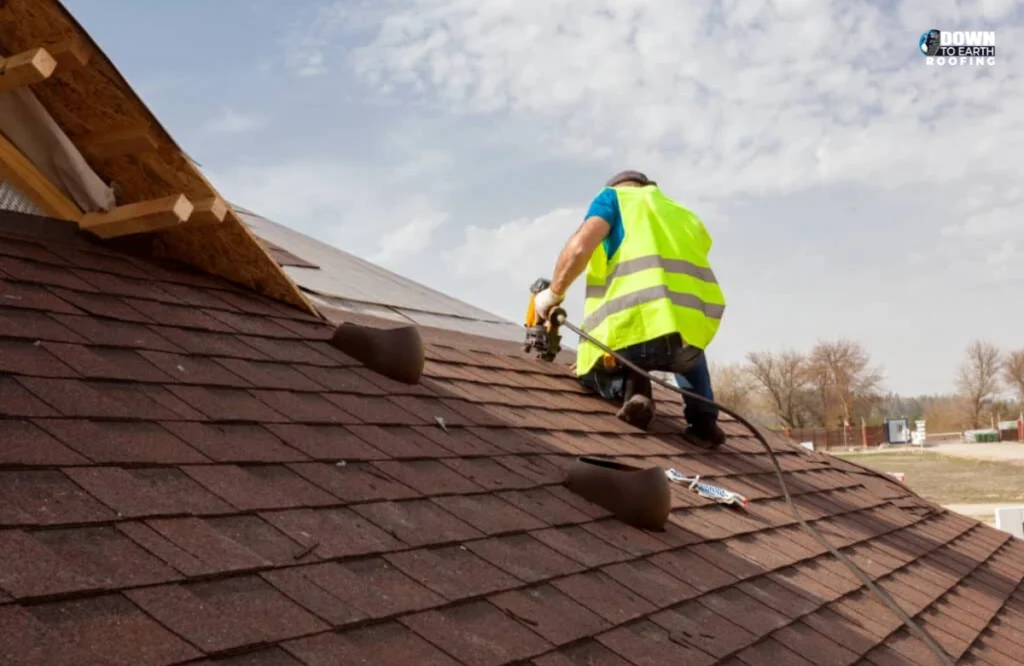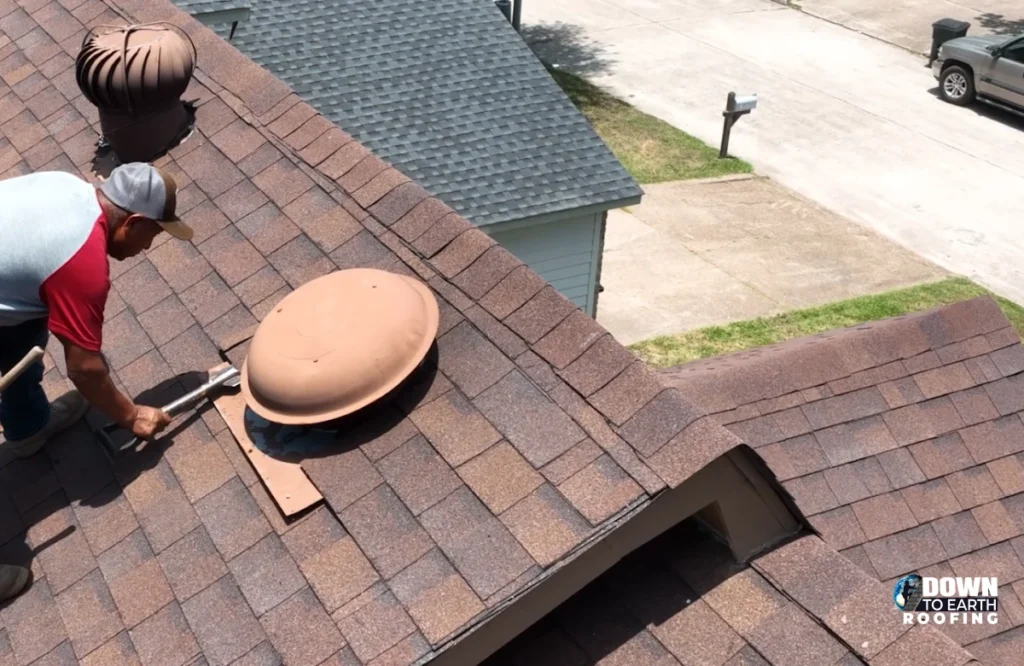Got damaged shingles on your roof? You’re not alone. Every year, thousands of homeowners face the same problem, whether from storms, aging, or wear and tear.
The good news? Many shingle repairs are DIY-friendly if you know what you’re doing. This guide walks you through everything from spotting damage to fixing it yourself.
Why You Should Repair Roof Shingles Immediately
Let’s cut to the chase: damaged shingles are trouble waiting to happen.
The Importance of Timely Shingle Repair
A single cracked or missing shingle might not seem urgent, but water doesn’t wait. Once moisture gets under your shingles, it attacks your roof deck, insulation, and eventually your ceilings.
Here’s what happens when you delay:
- Water seeps into tiny cracks and gaps
- Your roof deck starts rotting
- Insulation gets soaked and loses effectiveness
- Mold grows in hidden spaces
- Energy bills spike as your home loses efficiency
Fix problems within days, not weeks. A $50 roof repair today beats a $2,000 disaster later.
Common Causes of Roof Shingle Damage
Understanding why fix shingles on roof fail helps you catch problems early.
Wind Damage Shingles: What You Need to Know
Wind is brutal on roofs. Gusts over 50 mph can rip shingles right off, especially on older roofs.
How wind damages shingles:
- Lifts edges and corners
- Tears shingles completely away
- Bends and creases shingle tabs
- Damages nail seals
How to Spot Shingle Damage Before It Becomes a Big Issue
Regular checks catch problems while they’re still cheap to fix.
Quick inspection tips:
- Walk around your house every few months
- Use binoculars to scan your roof
- Check after every major storm
- Look for shingles in your yard or gutters
- Watch for dark spots or lifted edges

Don’t forget your attic:
- Shine a flashlight around
- Look for daylight coming through boards
- Check for water stains on rafters
- Feel insulation for dampness
Spring and fall are ideal inspection times. Spring reveals winter damage, while fall prepares you for harsh weather ahead.
Tools and Materials Needed for Shingle Roof Repair
Get everything ready before you climb up. Nothing’s worse than realizing you’re missing something halfway through.
Essential Tools for Fixing Asphalt Shingles
Basic tool list:
- Flat pry bar (12 inches or longer)
- Hammer or roofing nail gun
- Utility knife with hooked blades
- Tape measure
- Chalk line
- Caulking gun
- Putty knife
Safety gear (non-negotiable):
- Safety harness and roof anchors
- Non-slip work boots
- Work gloves
- Safety glasses
- Hard hat for steep roofs
A good pry bar makes all the difference. Get one with a slightly curved end that slides under shingles easily.
Materials You’ll Need for Roof Shingle Replacement
Shopping list:
- Replacement shingles (match your existing ones exactly)
- Roofing cement (trowel-grade and tube)
- Galvanized roofing nails (1¼ inches)
- Roofing underlayment (if deck is exposed)
- Tarps (for emergency coverage)
Pro tip on shingles: Bring a sample to the store. Colors and textures vary wildly between brands. What looks close online might look terrible on your roof.
Get cold-weather formula cement if you’re working below 50°F. Regular cement won’t stick properly in cold conditions.
Step-by-Step Guide to Repairing Roof Shingles
Ready to get your hands dirty? Let’s walk through the process.
How to Replace Shingles: A Simple Process
Replacing shingles isn’t rocket science, but technique matters.
The basic process:
- Lift the shingle above – Use your pry bar to gently lift the tabs covering the damaged shingle
- Remove the nails – You’ll find 4 nails in the damaged shingle plus 4 more from the shingle above
- Slide out the old shingle – Pull it down and out from under the upper course
- Slide in the new shingle – Work it up into position until it aligns with neighbors
- Nail it down – Use 4-6 nails in the right spots
- Seal it up – Apply cement under the shingle above and press down
Temperature matters: Shingles are easiest to work with between 50-85°F. Too cold and they crack. Too hot and they’re gooey.
How to Repair Shingles on Your Roof
Sometimes you don’t need full replacement. Small cracks and damage can be patched.
For minor damage:
- Clean the area thoroughly
- Apply roofing cement under the crack
- Press the shingle down firmly (hold for 30 seconds)
- Add another layer of cement on top
- Smooth it out with your putty knife
For lifted or curled shingles:
- Apply cement liberally underneath
- Press down hard
- Add a nail if needed
- Cover nail heads with cement
This works great for individual problems. But if you’re patching multiple spots all over your roof, replacement might make more sense.
Fixing Asphalt Shingles: Detailed Instruction
Let’s get into the nitty-gritty of a proper shingle replacement.
Step 1: Prep your replacement shingle
- Check it matches your existing shingles
- Trim if needed using a utility knife and straight edge
- Have all tools within reach
Step 2: Remove the damaged shingle
- Lift the shingle above with your pry bar
- Work slowly to avoid breaking good shingles
- Remove all 8 nails (4 from the damaged shingle, 4 from above)
- Slide the old shingle out gently
Step 3: Install the new shingle
- Slide it into position from below
- Work it up under the course above
- Check alignment with surrounding shingles
- Make sure it sits flat
- and even
Step 4: Secure it properly
- Drive 4 nails (6 in high-wind areas)
- Place nails about 5/8 inch from edges
- Position just below the adhesive strip
- Drive straight and flush (not too deep, not too shallow)

Step 5: Seal everything
- Lift the tab of the shingle above
- Apply roofing cement on its underside
- Press down over your new shingle
- Hold pressure for 30 seconds
Done! Your repair should last as long as the surrounding shingles.
How Much Does Roof Shingle Replacement Cost?
Money matters. Let’s break down what you’ll actually spend.
Understanding Roof Shingle Replacement Costs
DIY repairs save serious money compared to professional work. A single shingle replacement costs just $5-15 in materials versus $150-300 for professional installation. Small sections (5-10 shingles) run $50-150 DIY or $300-800 professionally. Extensive wind damage repairs cost $1,000-3,000, while full roof replacement ranges from $5,000-15,000+. If you don’t own tools and safety equipment, add another $150-350 to your DIY budget. The labor cost is where professionals get expensive. You’re paying for expertise, insurance, and equipment.
Factors affecting your costs:
- Materials: Shingle type (architectural vs. three-tab), quality grade, color matching, and quantity purchased
- Labor: Roof pitch, home height, accessibility, extent of damage, and your location
- Hidden expenses: Roof deck repairs, underlayment replacement, flashing repairs, waste disposal, and permit fees
Factors Affecting Roof Shingle Replacement Cost
| Category | Factors / Tips |
| Material Factors | – Shingle type: architectural vs. three-tab- Quality grade- Color matching (if discontinued)- Quantity (bulk pricing lowers cost) |
| Labor Factors | – Roof pitch (steeper = higher cost)- Home height- Accessibility issues- Extent of underlying damage- Location (city vs. rural rates) |
| Hidden Costs | – Roof deck repairs (rotted wood)- Underlayment replacement- Flashing repairs- Waste disposal- Permit fees (area-dependent) |
| DIY Savings | – Do it yourself (e.g., $500 job may cost ~$75 in materials) |
| Smart Buying | – Shop off-season (fall/winter)- Buy slightly extra (returns possible)- Compare suppliers- Ask about contractor discounts |
| Timing Strategies | – Off-season work = lower cost- Weekday appointments cheaper than weekends- Bundle repairs- Plan ahead (avoid emergency premiums) |
| Insurance Options | – Check policy for storm coverage- Know your deductible- Get professional documentation- File promptly |
| Maintenance Tips | – Clean gutters- Trim overhanging branches- Remove moss/algae early- Fix small issues before they grow |
When to Call a Professional for Roof Shingle Repair
DIY roof shingle repair is fine for small fixes like replacing a few shingles on a low-pitch, easy-to-access roof if you have the tools, skills, and safe weather. It’s best for single shingle replacements or minor sections under 10 shingles. But once the roof is steep, multi-story, or the damage is extensive, a pro is the safer bet. Call an expert if more than 20% of the roof is affected, the deck is unstable, or structural issues appear. Complex jobs like valley repairs, flashing, or ventilation damage shouldn’t be DIY. Also, consider safety gear, insurance coverage, and your comfort with heights before deciding. If any of these raise doubt, professional help is worth the cost.
Professional Asphalt Shingle Repair: When is it Necessary?
Repairs fix today’s problems, but maintenance prevents tomorrow’s. Keep your roof in top condition by cleaning gutters quarterly, inspecting after storms, and scheduling professional checks every 3-5 years. Trim branches at least 6 feet from your roof, remove moss and algae promptly, and ensure proper attic ventilation to prevent heat damage and ice dams. Fix small problems immediately before they escalate a $200 inspection might save you $5,000 in prevented damage. Regular maintenance extends your roof’s life by years and catches early signs of wear before leaks start, making it cheap insurance for your biggest investment.
Ready to Fix Those Shingles?
Repairing roof shingles doesn’t have to be intimidating. Armed with the right knowledge, tools, and safety precautions, many homeowners successfully handle their own repairs.
Remember the key points:
- Act quickly when you spot damage
- Use proper safety equipment always
- Match materials carefully for best results
- Know when to call a professional
- Maintain your roof to prevent future problems
Whether you’re replacing shingles after wind damage, fixing asphalt roof shingles, or tackling a complete shingle roof repair, taking action now protects your home and saves money long-term.
Got questions? Start with a thorough inspection, gather your materials, and take it one shingle at a time. Your roof and your wallet will thank you.
Final Thoughts: Ensuring Your Roof Stays in Top Shape
Repairs fix today’s problems, but maintenance prevents tomorrow’s. Keep your roof in top condition by cleaning gutters quarterly, inspecting after storms, and scheduling professional checks every 3-5 years. Trim branches at least 6 feet from your roof, remove moss and algae promptly, and ensure proper attic ventilation to prevent heat damage and ice dams. Fix small problems immediately before they escalate a $200 inspection might save you $5,000 in prevented damage. Regular maintenance extends your roof’s life by years and catches early signs of wear before leaks start, making it cheap insurance for your biggest investment.
Frequently Asked Questions About Roof Shingle Repair
How much does it cost to replace a few shingles?
DIY costs $5-15 per shingle ($50-150 for 5-10 shingles), while professional replacement runs $150-300 per shingle or $300-800 for small sections.
Can I repair roof shingles myself?
Yes, if you’re comfortable with heights and have basic DIY skills, though steep roofs, extensive damage, or structural issues require a professional.
How long do asphalt shingles last after repair?
Properly repaired shingles last as long as surrounding shingles typically 10-20 years depending on your roof’s age and the quality of repair work.
What’s the best temperature to replace roof shingles?
Work between 50-85°F for best results shingles become too brittle in cold weather and too soft in extreme heat.
How do I know if my roof needs repair or full replacement?
Repair if damage affects less than 20% of your roof; replace if you have widespread damage, your roof is over 20 years old, or multiple leak areas exist.
Will insurance cover wind damage to my roof shingles?
Most policies cover sudden storm damage, but you must document it immediately with photos and file claims promptly age-related wear isn’t covered.


